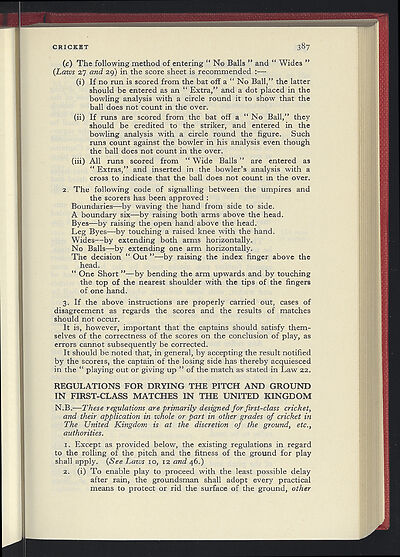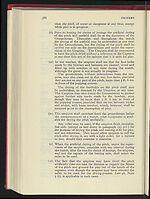1959-60
(453)
Download files
Complete book:
Individual page:
Thumbnail gallery: Grid view | List view

CRICKET
3
8
7
(c) The following method of entering " No Balls " and " Wides "
(Laws 27 and 29)
in the score sheet is recommended
(i) If no run is scored from the bat off a " No Ball," the latter
should be entered as an " Extra," and a dot placed in the
bowling analysis with a circle round it to show that the
ball does not count in the over.
(ii) If runs are scored from the bat off a " No Ball," they
should be credited to the striker, and entered in the
bowling analysis with a circle round the figure. Such
runs count against the bowler in his analysis even though
the ball does not count in the over.
(iii) All runs scored from "Wide Balls" are entered as
" Extras," and inserted in the bowler's analysis with a
cross to indicate that the ball does not count in the over.
2. The following code of signalling between the umpires and
the scorers has been approved
Boundaries—by waving the hand from side to side.
A boundary six—by raising both arms above the head.
Byes—by raising the open hand above the head.
Leg Byes—by touching a raised knee with the hand.
Wides--by extending both arms horizontally.
No Balls—by extending one arm horizontally.
The decision " Out "—by raising the index finger above the
head.
" One Short "—by bending the arm upwards and by touching
the top of the nearest shoulder with the tips of the fingers
of one hand.
3. If the above instructions are properly carried out, cases of
disagreement as regards the scores and the results of matches
should not occur.
It is, however, important that the captains should satisfy them-
selves of the correctness of the scores on the conclusion of play, as
errors cannot subsequently be corrected.
It should be noted that, in general, by accepting the result notified
by the scorers, the captain of the losing side has thereby acquiesced
in the " playing out or giving up " of the match as stated in Law 22.
REGULATIONS FOR DRYING THE PITCH AND GROUND
IN FIRST-CLASS MATCHES IN THE UNITED KINGDOM
N.B.—These regulations are primarily designed for first-class cricket,
and their application in whole or part in other grades of cricket in
The United Kingdom is at the discretion of the ground, etc.,
authorities.
i. Except as provided below, the existing regulations in regard
to the rolling of the pitch and the fitness of the ground for play
shall apply.
(See Laws
io,
12 and 46.)
2. (i) To enable play to proceed with the least possible delay
after rain, the groundsman shall adopt every practical
means to protect or rid the surface of the ground,
other
11
3
8
7
(c) The following method of entering " No Balls " and " Wides "
(Laws 27 and 29)
in the score sheet is recommended
(i) If no run is scored from the bat off a " No Ball," the latter
should be entered as an " Extra," and a dot placed in the
bowling analysis with a circle round it to show that the
ball does not count in the over.
(ii) If runs are scored from the bat off a " No Ball," they
should be credited to the striker, and entered in the
bowling analysis with a circle round the figure. Such
runs count against the bowler in his analysis even though
the ball does not count in the over.
(iii) All runs scored from "Wide Balls" are entered as
" Extras," and inserted in the bowler's analysis with a
cross to indicate that the ball does not count in the over.
2. The following code of signalling between the umpires and
the scorers has been approved
Boundaries—by waving the hand from side to side.
A boundary six—by raising both arms above the head.
Byes—by raising the open hand above the head.
Leg Byes—by touching a raised knee with the hand.
Wides--by extending both arms horizontally.
No Balls—by extending one arm horizontally.
The decision " Out "—by raising the index finger above the
head.
" One Short "—by bending the arm upwards and by touching
the top of the nearest shoulder with the tips of the fingers
of one hand.
3. If the above instructions are properly carried out, cases of
disagreement as regards the scores and the results of matches
should not occur.
It is, however, important that the captains should satisfy them-
selves of the correctness of the scores on the conclusion of play, as
errors cannot subsequently be corrected.
It should be noted that, in general, by accepting the result notified
by the scorers, the captain of the losing side has thereby acquiesced
in the " playing out or giving up " of the match as stated in Law 22.
REGULATIONS FOR DRYING THE PITCH AND GROUND
IN FIRST-CLASS MATCHES IN THE UNITED KINGDOM
N.B.—These regulations are primarily designed for first-class cricket,
and their application in whole or part in other grades of cricket in
The United Kingdom is at the discretion of the ground, etc.,
authorities.
i. Except as provided below, the existing regulations in regard
to the rolling of the pitch and the fitness of the ground for play
shall apply.
(See Laws
io,
12 and 46.)
2. (i) To enable play to proceed with the least possible delay
after rain, the groundsman shall adopt every practical
means to protect or rid the surface of the ground,
other
11
Set display mode to:
![]() Universal Viewer |
Universal Viewer | ![]() Mirador |
Large image | Transcription
Mirador |
Large image | Transcription
| Games and sports in the army > 1959-60 > (453) |
|---|
| Permanent URL | https://digital.nls.uk/248868927 |
|---|
| Description | 'Games and Sports in the Army' was an annual publication produced by the British War Office between the 1930s and 1960s. This included the Second World War. It outlines the rules and regulations for games and sports played by members of the armed forces. It features names and photographs of team members, and examples of contemporary advertising. |
|---|---|
| Shelfmark | GWB.52 |

